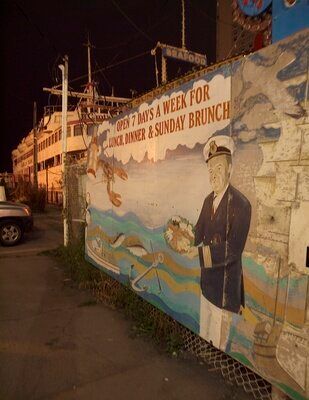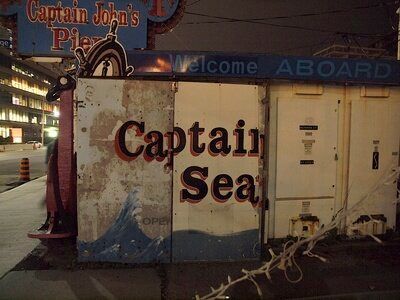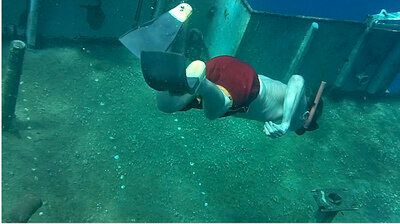...and Captain John doesn't even have to go down with his ship.

Sometime on my bum-busting boat ride out from Fort Myers, I realized that the city of Toronto could do something special for its diver tourism industry ... sink the Captain John Toronto Harbour Floating Restaurant.
I was in Florida last month, on board a small, open boat heading 21/2 hours out into the wilds of the Gulf of Mexico to scuba dive on a failed Florida Keys museum. I like hundreds of thousands of other divers will go just about anywhere to dive on a shipwreck. Thirty miles out and 90 feet down, the USS Mohawk, sunk just a year ago, is now one of the most sought after underwater attractions in Florida waters. And for the last few months she has hosted an underwater art show that is garnering global attention!

The Mohawk is sunk to create reef for divers.
Officials from the Fort Myers Sanibel Island tourism department learned an important commerce lesson from other port cities -- shipwrecks are a boost to the economy, help create habitats for fish stocks and attract free spending scuba divers from around the world! Cities that already boast successful artificial reef programmes include Victoria, Vancouver, Kingston, Halifax, Seattle, Pensacola, Fort Lauderdale, Miami, Key West, Nassau, and Georgetown (Cayman islands).
They are called artificial reefs -- unwanted ships that have been stripped of their engines and towed out to sea to be sunk with as much fanfare as possible. Within days of a ship's sinking, fish have moved in to seek shelter from predators and respite from underwater currents. Divers, snorkelers and fishermen soon follow.
Meanwhile back on shore, the community sees a boost in tourism, dive operators, fishing charter companies, marinas and hotels see an increase in business. For local government the creation of an artificial reef is often a judicious way to get rid of a dockside eyesore.
In the 1990s, I was involved in a project to investigate the possible creation of an artificial reef off Toronto's shoreline. Working with the Ontario Underwater Council, Ontario Place and the Canadian Navy, a Canadian Forces research submarine was sent down to examine the lake floor on the south side of Toronto Island.
We were looking for a flat firm stretch of lakebed 100 ft down where we could sink a decommissioned Canadian warship. The site had to be out of the shipping lanes, away from water intake pipes and close enough to shore to be easily reached by dive and fishing boats. There were three likely spots located in a day of diving with the submarine, all within a mile of shore.
What scuttled the plan to scuttle a warship off Toronto's coast was the cost of acquiring a suitable wreck. In those days the Navy worked with the internationally respected Artificial Reef Society of British Columbia to turn mothballed destroyers into diveable reefs. The Navy was willing to consider donating a decommissioned destroyer that was laid up in the Maritimes. However, the cost of making the ship environmental safe to sink, coupled with the cost of towing her to Lake Ontario and sinking her, was beyond the fund raising capability of the project.
Almost 22 years later the Ontario Underwater Council (OUC) is still hoping that a ship can be sunk for the enjoyment of some 200,000 active divers in the province, and for an even larger number of divers in North Eastern United States. The Canadian Navy is less inclined these days to donate ships because of the money they can be raise simply by selling worn-out vessels as scrap metal.

The bow of Captain John's.
What is needed in Toronto is a large ship that won't cost much money to acquire, is docked downtown (to give cleaning crews easy access to her) and is considered by the city government to be an eyesore that deserves to be sent to the bottom.
Sounds just like the Captain John Toronto Harbour Floating Restaurant. The former cruise ship is permanently moored (some say permanently mired) in Lake Ontario at the foot of Yonge Street. The MS Jadran was built in 1957 and sailed in the waters off Yugoslavia until 1976. She was brought to Toronto, tied up at dock almost 40 years ago and has never sailed again.
Her owner is mired in debt, the restaurant is closed and the ship is unsailable. Attempts to sell her have failed and the city is looking for ways to move the ship off the waterfront and recoup an estimated $600,000 in back taxes that are owned on the hulk.
Sinking the ship would help the city, it would clean up Harbourfront and it would create an instant dive attraction. Dive boats departing from marinas from Hamilton to Oshawa would service the site.
If she were to be sunk in the lee of the Toronto Island, the steel hull of the Captain John boat would sit unmovable on a firm sand and stone bottom, away from any deepwater current. Her upper deck would be an estimated 30 feet from the surface, easily reachable for sport divers, yet deep enough not to impact on recreational boating in the area.

At 296 ft in length and some 70ft in height Captain John's is a seagoing sized ship, twice the size of the warship sank near Fort Myers. As a cruise ship she could accommodate 400+ passengers. As a restaurant 250 diners could be accommodated in single seating. As a shipwreck it would take two or three dives to see all of her and there is enough room that 50 divers could tour her underwater without bumping into one another at any given time.
The last time that the OUC investigated sinking a ship, the dive season in Toronto, was confined to the summer and fall, because Lake Ontario is so cold underwater. Nowadays, with the advent of affordable lightweight dry suits that keep divers both dry and warmish underwater, scuba can be an almost year round activity in the Great Lakes.

There are two major shipwrecks in Toronto waters, but, there is little left to see of these 19th century wrecks. No, most Toronto wrecks divers head to Tobermory (site of a Federal underwater shipwreck park), Kingston and the St Lawrence River to dive on accessible and more intact shipwrecks.
There are already dive shops and fishing charter operations that could take visitors to any new wreck near the Toronto harbour. A U.S. government study on the economic impact of the sinking of the USS Vandenberg near the city of Key West found that over 100 new permanent jobs in the dive and tourism industries have been created because of the interest in the artificial reef, with over $7 million being injected into the local economy each year.
While no economic studies of a similar nature have been conducted in Ontario, anecdotal information indicates that the creation of an artificial reef near the Kingston Harbour (the sinking of a decommissioned Wolf Island ferry boat) and another in Tobermory (the steel hulled 187 ft Niagara II) have taken pressure off existing historical shipwrecks, increased dive tourism and created fish habitats.
Meanwhile, back in Fort Myers the art work that was on the wreck of the Mohawk will soon be on display, above water, in a local art gallery.
When I visited the Mohawk I spent my half-hour underwater taking in the sunken art show. Dodging large 300 pound Jewfish and always mindful of a man-sized bull shark that is known to cruise the decks of this WW2 cutter, I photographed a dozen different pictures by Austrian photographer Andreas Franke that hung (using big magnets) on the hull of the ship. There were two other dive boats and a fishing charter around the wreck when I dove on her.

A tourist swims on a Cayman Island artificial reef.
So popular has the Fort Myer's artificial reef project been (they have been creating artificial reefs sinc1981including 6 ships) that they already have plans to sink more ships near the Mohawk. This time though, they plan to bring a bit of Hollywood to the scuttling of two derelict ships -- a pirate battle where both vessels lose, and the dive community wins.
Would a modern day Jack Sparrow raise his Jolly Roger flag and make the Captain John an underwater attraction? Aye matey and the dive community would pay to daily act as her ghostly crew.